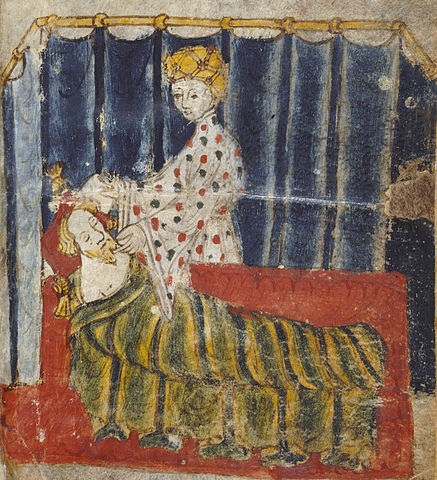Sir Gawain and the Green Knight is a Middle English alliterative poem from the 14th century. It is a chivalric romance that uses the folkloric motifs of the beheading game and the exchange of winnings. The poem is from a single surviving manuscript known as Cotton Nero A.x which also hold three other narrative poems called; Pearl, Purity, and Patience. These three poems are of a Christian religious nature as is the Sir Gawain poem while many people see it as also containing pagan allusions. The author of the manuscript is unknown but generally referred to as either the Gawain Poet or the Pearl Poet. There are many different ways to interpret Sir Gawain and the Green Knight but what is provided here is a brief synopsis of the poem.
Brutus of Troy and the Founding of BritainThe poem begins by mentioning the mythical founding of Britain by Brutus of Troy in the Historical Prologue and tells how after the fall of Troy the descendants of the exiles founded new cities and countries. According to the poem, Rome was founded by Romulus, Tuscany by Tiscius, Langoberde begins the settlement of the country later called Lombardy and Brutus became the founder of Britain. This information is designed to give Camelot political significance and legitimacy and introduces King Arthur the noblest and greatest king and leader of the country. This also gives him historical significance and legitimacy while also linking the poet’s own text with such classics as Virgil’s Aeneid, providing a literary link to those ancient times.
The Appearance of the Green Knight
The story begins in Camelot on the feast of New Year’s Day with the members of Arthur’s court giving and receiving presents from one another when Arthur requests to see or hear of a thrilling experience of exploit from someone before the feast commences. Apparently, in answer to this request there rides into the hall upon a massive green horse the huge figure of a knight. He is not dressed for battle wearing and not wearing armor but his clothing and even his skin and hair are all green. In one hand he holds a most splendid battle axe while in the other he holds a branch of holly.
The Christmas Game
The Green Knight refused to enter into combat with anyone declaring there was no one present who could match him. Instead he invited any who dared to take part in a special Christmas game. Explaining the rules he tells them that someone must strike him one blow with his axe but within one year and a day they must themselves take a blow from him. Whoever decides to play can keep the axe. On hearing these terms all the knights present at first refused to play but when it appeared that no one had the courage Arthur agreed. However, The youngest knight present, Sir Gawain, offered to step in and play the game for him which Arthur and the Green Knight accepted.
The Green Knight knelt and bows his head to receive a blow which is duly given by Sir Gawain severing the head from the body in one stroke. After the blow is delivered to the shock of all present the Green Knight is not killed but picking up his severed head mounts his horse. Holding the severed head to face Queen Guinevere the lips speak reminding Gawain and all those present that the two players in the game must meet again at the Green Chapel within the agreed space of time.
Read More







 RSS Feed
RSS Feed
